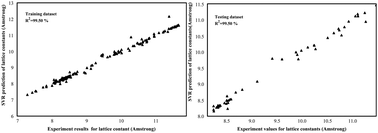Modeling and prediction of lattice parameters of binary spinel compounds (AM2X4) using support vector regression with Bayesian optimization
Abstract
The lattice constants of spinel compounds AM2X4 are correlated with the constituent elemental properties using support vector regression (SVR) optimized with Bayesian optimization. A total of 185 spinel compounds of different groups were used for model development and validation. The ionic radii (RA, RX, RM) and electronegativity values χA, χM and χX) of constituent elements were considered as inputs for the model development. A systematic analysis of the impact of each of the inputs revealed that the set of inputs with the optimum prediction performance are RA, RX, RM, χA, χM. The generalization of the model was tested on 52 binary spinel compound datasets. The proposed model exhibited impressive accuracy as measured by high correction and low root mean square error of 99.50 percent and 0.1128 Armstrong, respectively. The extrapolating ability of the model was extended to new tertiary spinel compounds that comprise cation mixing at A and M sites, and ionic substitution on stable parent spinel structures/lattices. The results obtained are very promising which shows that in the search for new materials for different applications, the developed SVR model could be used for screening potential spinel compounds, consequently speeding up the process of material development and applications.



 Please wait while we load your content...
Please wait while we load your content...